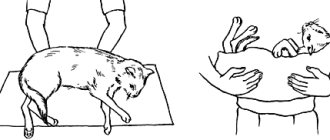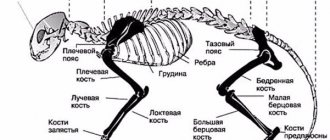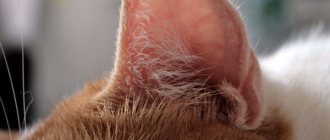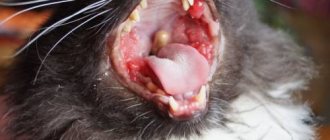Signs of a fracture
According to statistics, injuries accompanied by broken limbs are suffered by pets who regularly visit the street. Unsuccessful jumps, climbing trees, fights with street cats can cause damage to the integrity of the bones. If the owner believes that the cat has an injured limb, the pet should be taken to the veterinarian as soon as possible.
Fractures are divided into two types: open and closed, each injury has its own distinctive features.
The presence of the first type of traumatic injury looks like this:
- a gaping wound can be found on the paw (front or back),
- bone protrudes from the damaged area,
- the wound is bleeding heavily.
The injury is considered very serious and can lead to shock, the development of severe inflammatory processes, and death due to bleeding. It is impossible to cure an animal on your own; you cannot do without a trip to the veterinary clinic.
The cat may require serious surgery, because fragments of broken bone may remain in the wound, and not everyone can stop the bleeding at home.
In the second case, the cat exhibits the following symptoms:
- the pet is unable to step on a limb even for a short time,
- screams loudly in pain when touched,
- paw swells
- under the fur you can find a large hematoma at the injured site,
- the bone is not mobile in the joint; a crunching sound is heard upon palpation.
The damage is extremely severe; the absence of blood and a gaping wound can mislead the owner. An animal experiencing shock experiences virtually no pain, but a pet can only receive quality care for a closed fracture from a veterinarian.
Be sure to read:
Vaccinations for cats: what they are needed for, when and which ones are given, table by age, pros and cons
Types of fractures
Depending on the time of occurrence, veterinarians are faced with genetic and acquired fractures. Congenital fractures account for about 2.5% of cases. During the development of kittens in the womb, there may be compression of the fetuses by the uterus, as well as tension during the birth process.
The development of rickets, osteoporosis and osteomalacia due to imbalances in the cat’s diet during the period of gestation of kittens even before birth, leads to fractures of the front or hind limbs in babies. Acquired damage to bone structures is detected when the rules of obstetric care are violated, as well as at the stage of postnatal care.
In veterinary surgery, several types of acquired fractures are distinguished. They depend on the main factors - traumatic or associated with pathology. In representatives of the cat family, one of the main factors that provoke a fracture is trauma from a fall from a great height. In addition, a cat walking on the street without the supervision of its owner may suffer from a gunshot wound when the animals are hunted by their ardent haters.
Fracture is formed as a result of the development of bone pathology in osteosarcomas, osteomalacia, when there is a loss of strength in the tissue structure. The nature of the damage to the tubular bone is also taken into account when making a diagnosis.
There are open, closed and incomplete (partial) paw fractures. Based on the direction of the damage to the bone structure, veterinary medicine specialists distinguish the following types:
- transverse;
- longitudinal;
- oblique;
- screw (manifests itself when the animal’s paws get stuck);
- splintered;
- jagged, resulting from a lack of minerals or from pathological fractures associated with disease.
First aid
Algorithm of actions:
- If there is a bleeding wound, you should initially stop the bleeding and clean the wound surface of foreign objects. You can stop the bleeding with a sterile bandage, a clean cloth, and pressing the swab against the wound. If there is heavy bleeding from a damaged vessel, applying a tourniquet or bandage above the site of injury will help. The tourniquet should remain on the paw for no more than half an hour, and the time when the tight bandage was applied should be recorded.
- Treat the wound surface with antiseptic preparations.
- Having stopped the bleeding, fixation should be carried out. The splint does not apply to the paw; a piece of wooden slats or a school ruler will do.
- Relieve pain by giving your pet painkillers and sedatives.
Fractured paw in a cat
Most often, the fracture occurs in the hind legs.
But when you fall, you may encounter foreign objects, tree branches, for example, that knock down the landmark. Cats break their paws in road accidents and their hind legs are often affected . With the arrival of spring, veterinary clinics are filled with falling cats. They fall from all places from which you can fall: from trees, from balconies, from windows, from air conditioners. Heights and obstacles vary, as does luck. The result is a fracture.
Signs of a fracture in a cat
When a paw is broken, it begins to swell.
You can tell if your pet has a broken leg at first glance:
- the animal stands on 3 legs, squeezing the fourth;
- the paw swells at the site of the fracture;
- the paw has an unnatural position, is tucked in, and may even be turned in the other direction;
- when checking with your fingers, you hear a crunch and feel the displacement of the bones;
- the cat is in pain and protects the sore spot from touching, cries and complains.
The fracture can be closed, it can be determined by the above signs and open. With an open fracture, it is difficult to make a mistake: the wound is visible, tendons and ligaments are torn, and sometimes broken bones with jagged edges may protrude. Sometimes there is heavy bleeding.
Competent transportation
After providing first aid, you should correctly deliver your pet to the doctor so that the paw does not suffer even more during transportation.
For transportation:
- prepare a smooth, even board, a piece of plywood, wrapping the carrier in cloth;
- tie the sick animal with a wide bandage to an improvised carrier under the front and above the hind legs;
- place on a flat surface, for example: on the back seat of a car (if the patient is accompanied by a member of the household who is calming the cat on the way to the clinic), on the front passenger seat (if transportation is carried out without an assistant).
During transportation, you need to constantly stroke your pet and talk in a calm tone to relieve additional stress.
Symptoms: how to tell if a bone is broken?
The injured limb of the animal cannot move fully.
A bruised cat's paw is accompanied by swelling, slight lameness, and pain. After 2-3 days, improvement occurs, and complete recovery occurs within a week. When a limb is dislocated, it looks deformed, hurts, and the animal cannot stand on it. Depending on the location, the signs of a fracture differ as shown in the table:
| Type of injury | Symptoms of a fracture |
| By localization | |
| Damage to the front paw | Severe pain, the animal does not allow you to touch the limb |
| Intensified leg licking | |
| Swelling, puffiness | |
| Limited mobility | |
| Finger fracture | The pad and phalanx become swollen |
| The cat tries not to step on his paw | |
| Compression fracture of the spine | Back deformity |
| Partial or complete paralysis of the limbs | |
| Involuntary urination or bowel movements, constipation | |
| Hip fracture in a cat | Difficulty or lack of movement |
| Hind legs move apart | |
| Unsteady, unsteady gait | |
| Problems going to the toilet | |
| Fracture of a cat's rib or scapula | Unnatural pose |
| Frequent shallow breathing | |
| Abnormal bone mobility | |
| Blood from the mouth if internal organs are hit by bone fragments | |
| By variety | |
| Closed | The integrity of the skin is not compromised |
| Limb deformity | |
| Severe pain, anxiety | |
| The cat drags his sore paw, on which a large hematoma appears | |
| Open | Wound, bleeding |
| Bone fragments visible through damaged skin | |
| Severe pain syndrome | |
| Possible fainting due to pain shock | |
Fracture: treatment and care
Closed fractures are treated with conservative methods. After the initial examination and x-rays, the veterinarian fixes the limb with a plaster.
For a speedy recovery, I prescribe for my pet: a regime of maximum limitation of mobility, vitamin supplements, means to strengthen bone tissue, and physical therapy.
Be sure to read:
How to treat a cat’s wound: treatment of superficial and deep injuries, what to do if it festers
Open fractures require surgery. The veterinarian sets the bone, removes fragments, and fixes the damage with a pin or knitting needle. The animal is prescribed antibiotics and vitamins.
During the rehabilitation period, the owner should limit the pet’s mobility by placing it in a spacious container. After removing the cast, massage the healed paw daily and introduce foods that promote osteosynthesis (bone tissue regeneration) into the diet.
How doctors can help
Before choosing the most effective treatment method, the veterinary surgeon will examine the injured limb and order an x-ray examination. The method allows not only to confirm the diagnosis, but also to determine the location, type and complexity of the fracture, and the presence of damage in the periosteal structures. X-ray examination, as well as palpation of the injury, are carried out after preliminary anesthesia.
Conservative treatment
Closed and uncomplicated fractures in small animals can be successfully treated with conservative methods. First of all, pain shock is eliminated and the pet is anesthetized. In order to restore the integrity of the bone, immobilization of the damaged limb is used using a splint or splint.
The main condition for the rapid and correct fusion of bone fragments is the limitation of the animal’s mobility. Physiotherapy, vitamin therapy, and drugs that improve osteosynthesis will help speed up the regeneration process.
Operation
Complicated types of fractures require surgical intervention. The operation allows you to set large bone fragments or remove small ones. It is important to perform osteosynthesis as quickly as possible after the fracture is detected. Modern veterinary surgery involves the use of fixing metal structures (pins, knitting needles, plates, etc.) in osteosynthesis. Metal structures made from special steel and titanium remain in the animal’s body for life.
Control radiograph of the cat after surgery; a metal plate was installed at the fracture site.
Surgical intervention will also be required if, for any reason, conservative treatment methods do not result in complete recovery. In this case, the surgeon resorts to deliberately breaking the improperly fused bone.
Causes
If a cat lives in the house, you need to take into account the characteristics of its character. Some of them pose a potential threat to the health of the animal. The animals are extremely curious, and they also have a very strong hunting instinct.
A cat can forget about everything in the world if it is chasing a bird or a fly. If she is sitting on the edge of the windowsill at this time, the matter may end in injury.
The most common causes of paw fractures in cats are:
- jumping from heights;
- injuries on the highway;
- accidental injuries (for example, being caught in a door);
- development of osteoporosis, rickets or osteomalacia;
- blows that were inflicted by people or animals;
- congenital fragility of the musculoskeletal system - as a rule, this feature is found in purebred animals;
- exposure to external factors that weaken the immune system and reduce bone density;
- osteosarcoma;
- infectious lesions.
According to statistics, paw fractures are most common among felines. The pelvis, tail or spine are much less likely to be injured.
Recovery period
How long it takes for a cat’s fracture to heal depends on many factors. First of all, the location and severity of the damage play an important role; complex multiple fractures require more time for regeneration than simple ones. The recovery period is largely influenced by the age and condition of the animal; for example, in young healthy cats, tissues grow together much faster. Particular attention should be paid to the quality of postoperative care, since it is on compliance with all the doctor’s recommendations that the cat’s recovery after a fracture will depend. One way or another, the life and health of a pet after an injury is a difficult path that the doctor, the owner and the animal itself must go through together.
How to transport a cat to the clinic
To transport your cat to the veterinarian, place it in a hard shipping container. This is important, especially if spinal fractures are suspected.
At the clinic, doctors will be able to assess the general condition of the animal, stabilize it if necessary, and only then conduct a diagnosis.
Once the diagnosis is made, the doctor will be able to announce the prognosis and plan the necessary treatment. Depending on the complexity and nature of the injuries, this may be an urgent or planned operation, or it may be conservative therapy.
Fracture treatment
Once the diagnosis is made, treatment of the fracture begins. Treatment of such patients is usually carried out in several stages and includes a number of specific measures. First of all, it is necessary to carry out a series of therapeutic procedures to stabilize the patient’s general condition.
After the patient’s condition has stabilized, they begin directly to treat the fracture itself. Treatment of the fracture itself is in most cases surgical, and includes immobilization of the fracture fragments and ensuring stability while maintaining the function of the damaged bone.
After surgical treatment, a number of therapeutic measures are prescribed to eliminate inflammation, accelerate healing and rehabilitate the patient.
What is a fracture
This concept includes 2 points: a violation of the natural state of bone tissue and the presence of a mechanical factor that caused the injury. A bone breaks if the force of an external force exceeds its strength.
Doctors divide all possible fractures into traumatic and pathological injuries. The former are a consequence of mechanical intervention.
In most cases, these are falls, car injuries, or dog bites.
The causes of pathological bone damage are diseases that have a negative effect on bone tissue. Such ailments include osteoporosis, metabolic disorders, oncology, hyperparathyroidism (leaching of calcium from the body due to poor nutrition).
Diagnostics
You can know for sure that a cat has a broken paw after examining the animal by a veterinarian. An examination is necessary to identify associated injuries, which usually occur after a fall from a height or strong mechanical impacts.
For example, a fracture of a cat’s hind leg is often diagnosed against the background of severe chest bruises and abdominal trauma.
The veterinarian must order an x-ray of the injured limb in order to assess the extent of damage to the animal’s health and draw up an individual therapy plan. Often, x-rays require preliminary anesthesia with sedatives.











